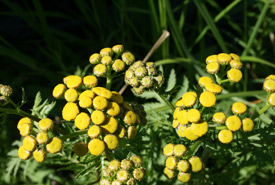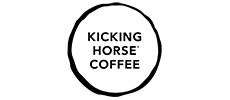
Common tansy (Photo by NCC)
Common tansy
Common tansy is native to Europe, and was introduced to North America in the 1600s as a horticultural and medicinal plant.
How is it identified?
Common tansy has yellow, button-like flowers and can grow to up to 1.5 metres high. It also has branched, often purplish-red stems and leaves that alternate along its stem.
How does it grow?
This plant reproduces by both seeds and rhizomes (underground horizontal roots). Seeds are frequently spread by animals and vehicles. Controlling seed dispersal is considered more crucial than controlling root spreading in combatting this species.
Where does it grow?
Common tansy has been documented in every region in Canada except Nunavut, but has the greatest impact on stream banks and native grasslands in the prairies and central BC. This species prefers areas with full sun and fertile, well-drained soil. It often grows on stream banks, pastures and other disturbed sites, such as roadsides.
What does it threaten?
In addition to outcompeting native plants, common tansy produces a toxic compound that can impact cattle and wildlife when ingested.
What is being done to control this species?
NCC regularly mows common tansy-infested areas to help decrease seed production. The most effective control methods are a combination of mowing or hand cutting with chemical control, as well as promoting competition by planting native vegetation.
How can you help?
Everyone can help win the battle against invasive species. Here are several ways you can do your part:
- Dispose of yard waste properly. Dumping yard waste in natural areas can introduce alien invasive species, which can thrive and spread. Even leaf piles can be problematic, as dumped piles can smother native vegetation. Contact your municipality to find out how to dispose of yard waste properly.
- Plant native species in your garden. There are lots of beautiful native species that attract native butterflies and birds, making your garden twice as beautiful. Native species are also adapted to our climate and often require less rigorous care than exotic species.
- Clean your shoes or bicycle tires when moving between designated trails in different areas. Invasive plants are often spread accidentally from seeds stuck in treads.
- Learn about the most invasive plants in your local area. Do an audit of your yard to ensure none are growing on your property.
- Report new occurrences of invasive plants to provincial invasive species councils or through apps, such as iNaturalist. By helping track the spread of invasive species, scientists and land managers can identify the best places and methods to control them.



